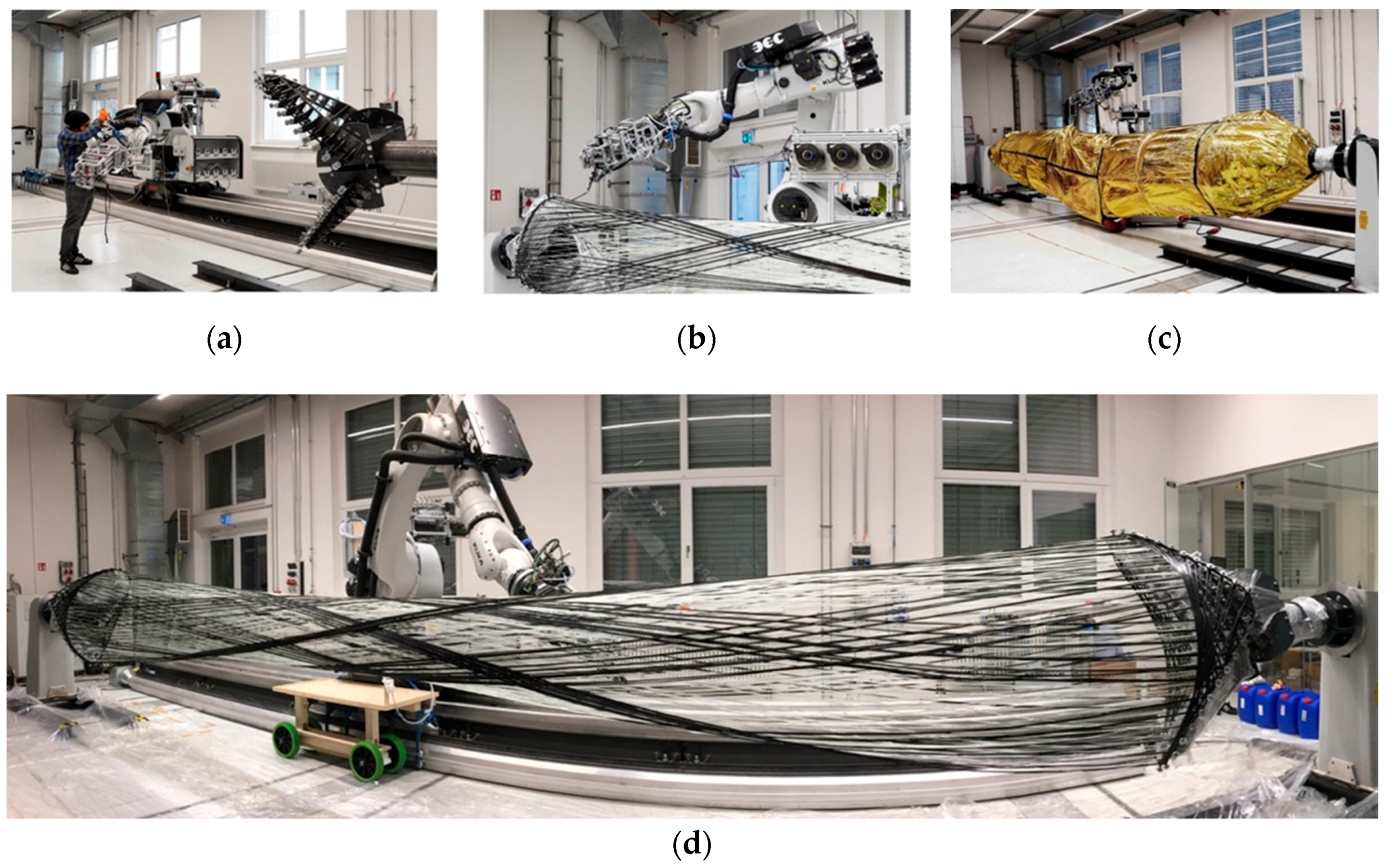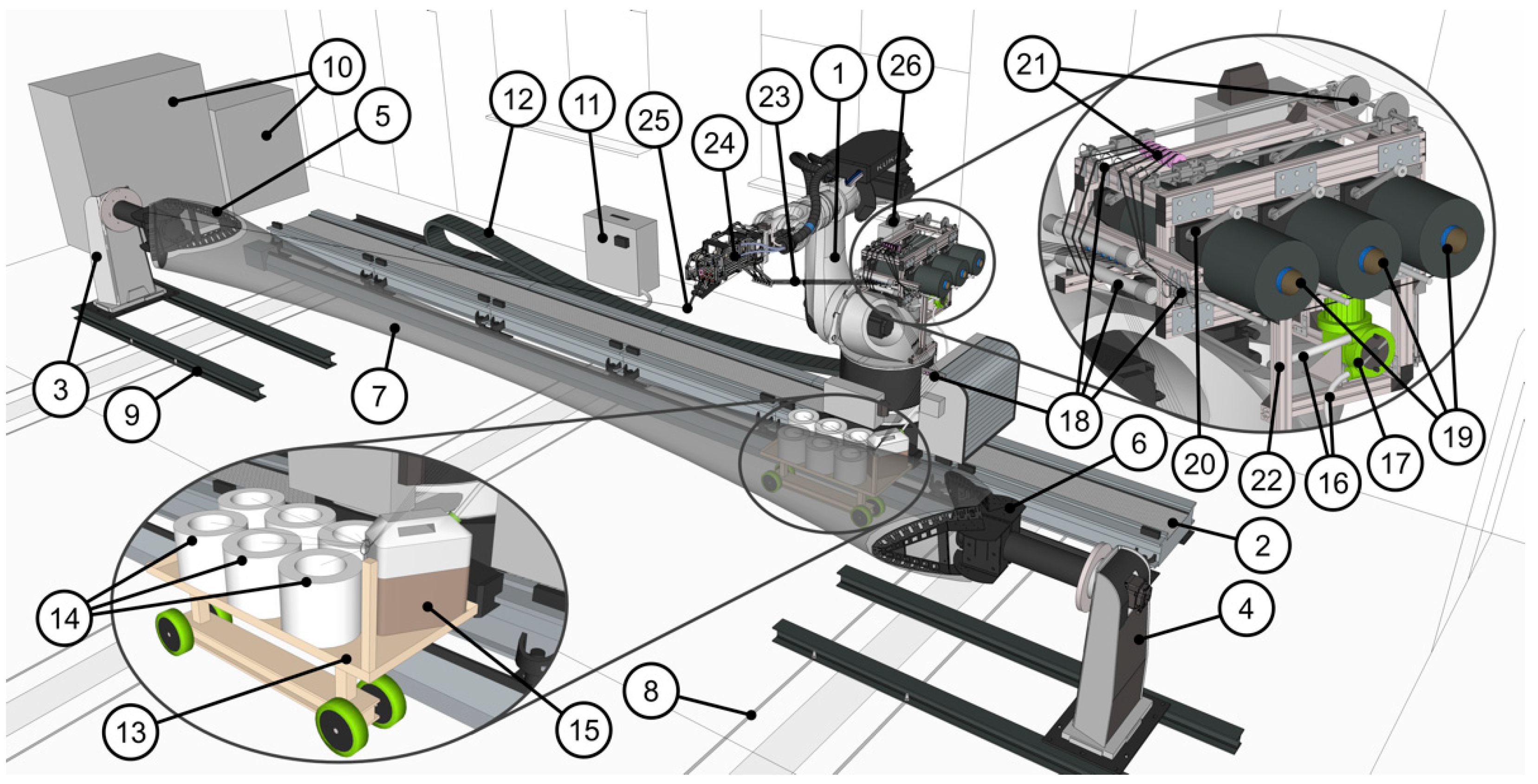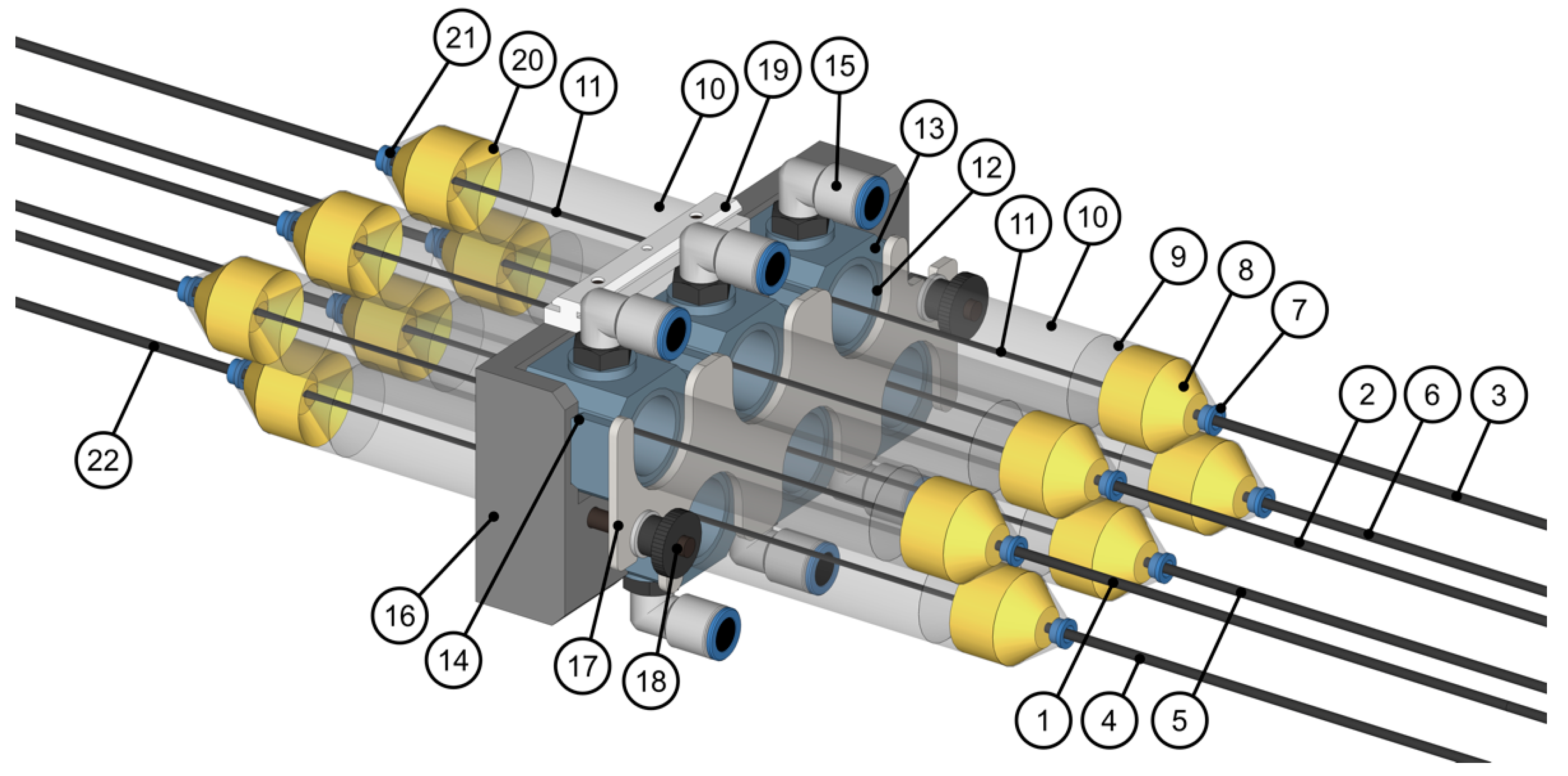Development of an Impregnation End-Effector with Fiber Tension Monitoring for Robotic Coreless Filament Winding
Abstract
1. Introduction
2. Materials and Methods
2.1. Large-Scale Cyber-Physical Winding Setup
2.2. Sensor-Supported Control through Feedback Loops
2.3. Robotic Winding End-Effector
2.3.1. Impregnation Unit Subsystem
2.3.2. Fiber Tension Sensor Subsystem
2.4. Material System for Large-Scale Fabrication
3. Results
3.1. Validation of the Upscaled Process
3.2. Impregnation Quality Evaluation
3.3. Analysis of Fiber Tension Sensor Data
4. Discussion and Conclusions
Supplementary Materials
Author Contributions
Funding
Data Availability Statement
Acknowledgments
Conflicts of Interest
References
- Liu, Y.; Zwingmann, B.; Schlaich, M. Carbon fiber reinforced polymer for cable structures: A review. Polymers 2015, 7, 2078–2099. [Google Scholar] [CrossRef]
- Schürmann, H. Konstruieren mit Faser-Kunstoff-Verbund, 2nd ed.; Springer: Berlin Heidelberg, Germany, 2007; pp. 11–17. [Google Scholar]
- Gil Pérez, M.; Rongen, B.; Koslowski, V.; Knippers, J. Structural design, optimization and detailing of the BUGA fibre pavilion. Int. J. Space Struct. 2020, 35, 147–159. [Google Scholar]
- Xing, J.; Geng, P.; Yang, T. Stress and deformation of multiple winding angle hybrid filament-wound thick cylinder under axial loading and internal and external pressure. Compos. Struct. 2015, 131, 868–877. [Google Scholar] [CrossRef]
- Wang, P.H.; Sterkenburg, R.; Kim, G.; He, Y. Investigating the void content, fiber content, and fiber orientation of 3d printed recycled carbon fiber. Key Eng. Mater. 2019, 801, 276–281. [Google Scholar]
- Mertiny, P.; Ellyin, F. Influence of the filament winding tension on physical and mechanical properties of reinforced composites. Compos. Part – Appl. S. 2002, 33, 1615–1622. [Google Scholar] [CrossRef]
- Zechmeister, C.; Bodea, S.; Dambrosio, N.; Menges, A. Design for Long-Span Core-Less Wound, Structural Composite Building Elements. In DMSB 2019—Impact: Design with All Senses, 1st ed.; Gengnagel, C., Baverel, O., Burry, J., Ramsgaard Thomsen, M., Weinzierl, S., Eds.; Springer: Cham, Switzerland, 2020; pp. 401–415. [Google Scholar]
- Sorrentino, L.; Anamateros, E.; Bellini, C.; Carrino, L.; Corcione, G.; Leone, A.; Paris, G. Robotic filament winding: An innovative technology to manufacture complex shape structural parts. Compos. Struct. 2019, 220, 699–707. [Google Scholar] [CrossRef]
- Zu, L.; Xu, H.; Wang, H.; Zhang, B.; Zi, B. Design and analysis of filament-wound composite pressure vessels based on non-geodesic winding. Compos. Struct. 2019, 207, 41–52. [Google Scholar] [CrossRef]
- Schulz, M.; Janssen, H.; Brecher, C. A digital shadow for the infrared-based tape laying process of tailored blanks out of thermoplastic unidirectional tape. Proc. CIRP 2019, 85, 224–229. [Google Scholar] [CrossRef]
- Clancy, G.; Peeters, D.; O’Higgins, R.M.; Weaver, P.M. In-line variable spreading of carbon fibre/thermoplastic pre-preg tapes for application in automatic tape placement. Mater. Design 2020, 194, 108967. [Google Scholar] [CrossRef]
- Dutra, T.A.; Ferreira, R.T.L.; Resende, H.B.; Guimarães, A. Mechanical characterization and asymptotic homogenization of 3D-printed continuous carbon fiber-reinforced thermoplastic. J. Braz. Soc. Mech. Sci. Eng. 2019, 41, 133. [Google Scholar] [CrossRef]
- Fijul Kabir, S.M.; Mathur, K.; Seyam, A.-F.M. A critical review on 3D printed continuous fiber-reinforced composites: History, mechanism, materials and properties. Compos. Struct. 2020, 232, 111476. [Google Scholar] [CrossRef]
- Tyler, K.L. Method and Apparatus for Continuous Composite Three-Dimensional Printing. U.S. Patent 10,744,707, 18 August 2020. [Google Scholar]
- Büchler, D.; Elsken, T.; Glück, N.; Sier, M.; Bludszuweit, S. Ultraleichte Raumzelle—Entwicklung von ultraleichten Großstrukturen in Faserverbund- und Hybridbauweise für den Schiffbau. In Statustagung Schifffahrt und Meerestechnik, 1st ed.; Forschungszentrum: Jülich, Germany, 2011; pp. 25–45. [Google Scholar]
- Prado, M.; Dörstelmann, M.; Menges, A.; Solly, J.; Knippers, J. Elytra Filament Pavilion: Robotic Filament Winding for Structural Composite Building Systems. In Fabricate 2017; Menges, A., Sheil, B., Glynn, R., Skavara, M., Eds.; UCL Press: London, UK, 2017; pp. 224–231. [Google Scholar]
- Bodea, S.; Zechmeister, C.; Dambrosio, N.; Dörstelmann, M.; Menges, A. Robotic coreless filament winding for hyperboloid tubular composite components in construction. Automat. Constr. 2021, 126, 103649. [Google Scholar] [CrossRef]
- Minsch, N.; Müller, M.; Gereke, T.; Nocke, A.; Cherif, C. 3D truss structures with coreless 3D filament winding technology. J. Compos. Mater. 2019, 53, 2077–2089. [Google Scholar] [CrossRef]
- Menges, A.; Knippers, J.; Wagner, H.J.; Zechmeister, C. Pilotprojekte für ein Integratives Computerbasiertes Planen und Bauen. In Baustatik—Baupraxis 14; Bischoff, M., von Scheven, M., Oesterle, B., Eds.; University of Stuttgart: Stuttgart, Germany, 2020; pp. 67–79. [Google Scholar]
- Reichert, S.; Schwinn, T.; La Magna, R.; Waimer, F.; Knippers, J.; Menges, A. Fibrous structures: An integrative approach to design computation, simulation and fabrication for lightweight, glass and carbon fibre composite structures in architecture based on biomimetic design principles. Comput. Aided Design 2014, 52, 27–39. [Google Scholar] [CrossRef]
- Imamura, T.; Kuroiwa, T.; Terashima, K.; Takemoto, H. Design and tension control of filament winding system. In Proceedings of the 1999 IEEE International Conference on Systems, Man, and Cybernetics, Tokyo, Japan, 12–15 October 1999; IEEE: New York, NY, USA, 1999; pp. 660–670. [Google Scholar]
- Yeung, M.F.; Falkner, A.H.; Gergely, S. The control of tension in textile filament winding. Mechatronics 1995, 5, 117–131. [Google Scholar] [CrossRef]
- Gloy, Y.; Beck, T.; Hehl, A.; Niebel, V.; Wischnowski, M.; Schulte Südhoff, E.; Raina, M.; Gries, T. Sensoren für Bioprozess- und Verfahrenstechnik. In Proceedings of the 11. Dresdner Sensor-Symposium, Dresden, Germany, 9–11 December 2013; AMA: Berlin, Germany, 2013; pp. 445–449. [Google Scholar]
- Mohamed, A.; Rana, A.; Motaz, A. Yarn tension control technique for improving polyester soft winding process. Sci. Rep. 2021, 11, 1060. [Google Scholar]
- La Magna, R.; Waimer, F.; Knippers, J. Coreless Winding and Assembled Core – Novel fabrication approaches for FRP based components in building construction. Constr. Build. Mater. 2016, 127, 1009–1016. [Google Scholar] [CrossRef]
- Bodea, S.; Dambrosio, N.; Zechmeister, C.; Gil Pérez, M.; Koslowski, V.; Rongen, B.; Dörstelmann, M.; Knippers, J.; Menges, A.; Kyjanek, O. BUGA Fibre Pavilion: Towards robotically-fabricated composite building structures. In Fabricate 2020; Burry, J., Sabin, J.E., Sheil, B., Skavara, M., Eds.; UCL Press: London, UK, 2020; pp. 234–243. [Google Scholar]
- Prado, P. Skeletal composites: Robotic fabrication processes for lightweight multi-nodal structural components. Constr. Robot. 2020, 4, 217–226. [Google Scholar] [CrossRef]
- Pan, N. Theoretical determination of the optimal fiber volume fraction and fiber-matrix property compatibility of short fiber composites. Polym. Compos. 1993, 14, 85–93. [Google Scholar] [CrossRef]
- Mindermann, P.; Gresser, G.T. Robotic 3D Deposition of Impregnated Carbon Rovings with Gradient Properties for Primary Structures. In Proceedings of the 69th International Astronautical Congress, Bremen, Germany, 1–5 October 2015; IAF: Paris, France, 2018. [Google Scholar]
- Rongen, B.; Koslowski, V.; Gil Pérez, M.; Knippers, J. Structural optimization and rationalization of the BUGA fibre composite dome. In Proceedings of the IASS Annual Symposium 2019—Structural Membranes, Barcelona, Spain, 7–10 October 2019; Lázaro, C., Bletzinger, K.-U., Oñate, E., Eds.; IASS: Madrid, Spain, 2019. [Google Scholar]
- Chang, C.; Han, Z.; Li, X.; Sun, S.; Qin, J.; Fu, H. A non-geodesic trajectory design method and its post-processing for robotic filament winding of composite tee pipes. Materials 2021, 14, 847. [Google Scholar] [CrossRef]
- Kuka KR 420 R3080—Technical Data Sheet. Available online: https://www.kuka.com/-/media/kuka-downloads/imported/6b77eecacfe542d3b736af377562ecaa/0000233239_en.pdf?rev=c80332ccaa9a4dcda3433ed8197bcd82&hash=606C12B8C4483F37AE4A8B70BD7147C6 (accessed on 17 April 2021).
- Kuka Industrial Robotics-Linear Units and Positioners—Technical Data Sheet. Available online: https://www.kuka.com/-/media/kuka-downloads/imported/9cb8e311bfd744b4b0eab25ca883f6d3/kuka_pb_positioners_linear_units_en.pdf?rev=5b41e95fde78472a8c152eb8f4b1c4e6 (accessed on 17 April 2021).
- Rhinoceros. Available online: https://www.rhino3d.com (accessed on 26 April 2021).
- Grasshopper. Available online: https://www.grasshopper3d.com (accessed on 26 April 2021).
- KUKA Application and Robot Programming—KRL (KUKA Robot Language). Available online: https://www.kuka.com/en-de/services/engineering/application-and-robot-programming (accessed on 26 April 2021).
- Radialkraft-Messwertaufnehmer der Baureihen M 1391 und M 1392—Technical Data Sheet. Available online: https://tensometric.de/pdf/daten/deutsch/1-rollen-systeme/M1391-92-D.pdf (accessed on 17 April 2021).
- Dambrosio, N.; Zechmeister, C.; Bodea, S.; Koslowski, V.; Gil Pérez, M.; Rongen, B.; Knippers, J.; Menges, A. Towards an architectural application of novel fiber composite building systems—The BUGA Fibre Pavilion. In Ubiquity and Autonomy, Proceedings of the 39th Annual Conference of the Association for Computer Aided Design in Architecture, Austin, TX, USA, 24–26 October 2019; ACADIA: Fargo, ND, USA, 2019; pp. 140–149. [Google Scholar]
- Teijin Tenax Filament Yarn—Product Data Sheet. Available online: https://www.teijincarbon.com/fileadmin/PDF/Datenblätter_en/Product_Data_Sheet_TSG01en__EU_Filament_.pdf (accessed on 17 April 2021).
- Owens Corning Pipestrand S2300 Single-End Roving—Product Information. Available online: https://www.owenscorning.com/en-us/composites/product/pipestrand-roving-s2300-and-s2500 (accessed on 17 April 2021).
- Bio-Composites and More GmbH - PTP-Resins—Product Information. Available online: https://bio-composites.eu/en/ptp-resins/ (accessed on 17 April 2021).
- Luo, J.; Ying, K.; Bai, J. Savitzky–Golay smoothing and differentiation filter for even number data. Signal Process. 2005, 85, 1429–1434. [Google Scholar] [CrossRef]








| Used Raw Material | Processing Method | Internal Interaction | Intended Function | Environmental Interaction | Form-Defining Characteristics |
|---|---|---|---|---|---|
| Teijin Tenax-E STS40 F13 48K 3200tex | robotic coreless filament winding and thermal curing | mutual displacement due to tension and friction, becoming a composite | reinforcement of the component | insignificant | lattice fiber composite structure conforming to the BUGA [38] building system type |
| Owens Corning PipeStrand S2300 2400tex LS BP11 S CF A | shaping of the fiber body by pushing carbon fiber outwards | insignificant | |||
| B.A.M. PTP resin | matrix of the composite, adhesive joint to the sleeves | aging due to sun expose, etc. | |||
| zinc-plated steel, 1.0718 | sleeves mounted by bolt connection | adhesive joint with C/GFRP | winding pins and force transmission sleeves | insignificant |
| Sample Location | Material | FVR | Sample Size |
|---|---|---|---|
| corner syntax | CFRP | 51.9 ± 2.0% | 8 |
| free spanning syntax | CFRP | 59.7 ± 1.5% | 8 |
| free spanning syntax | GFRP | 38.4 ± 3.0% | 12 |
Publisher’s Note: MDPI stays neutral with regard to jurisdictional claims in published maps and institutional affiliations. |
© 2021 by the authors. Licensee MDPI, Basel, Switzerland. This article is an open access article distributed under the terms and conditions of the Creative Commons Attribution (CC BY) license (https://creativecommons.org/licenses/by/4.0/).
Share and Cite
Mindermann, P.; Bodea, S.; Menges, A.; Gresser, G.T. Development of an Impregnation End-Effector with Fiber Tension Monitoring for Robotic Coreless Filament Winding. Processes 2021, 9, 806. https://doi.org/10.3390/pr9050806
Mindermann P, Bodea S, Menges A, Gresser GT. Development of an Impregnation End-Effector with Fiber Tension Monitoring for Robotic Coreless Filament Winding. Processes. 2021; 9(5):806. https://doi.org/10.3390/pr9050806
Chicago/Turabian StyleMindermann, Pascal, Serban Bodea, Achim Menges, and Götz T. Gresser. 2021. "Development of an Impregnation End-Effector with Fiber Tension Monitoring for Robotic Coreless Filament Winding" Processes 9, no. 5: 806. https://doi.org/10.3390/pr9050806
APA StyleMindermann, P., Bodea, S., Menges, A., & Gresser, G. T. (2021). Development of an Impregnation End-Effector with Fiber Tension Monitoring for Robotic Coreless Filament Winding. Processes, 9(5), 806. https://doi.org/10.3390/pr9050806







